Kwantlen University by the numbers: A calculated look at our school’s student demographics
January 14, 2010 by Mitch Thompson · Leave a Comment
By Jacob Zinn & Mitch Thompson
To better understand how the generational groups at Kwantlen work, the Chronicle polled a sample of students from three campuses: Surrey, Richmond and Langley.
The students were asked what year they were born, how many computers they own, if they have a Facebook page and whether or not they agreed with the generational values usually associated with people their age.
They were then given a five-point history quiz in which major events were named. Students had to give a basic description of 9/11, the Challenger shuttle disaster, JFK’s assassination, knowledge of the Berlin Wall and the bombing of Pearl Harbour.
The following graphs are the compiled results.

First music format purchase - Generation Y

First music format purchase - Generation Z
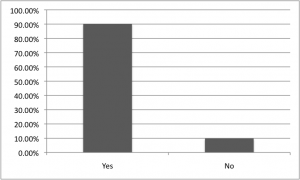
Facebook page - Generation Y
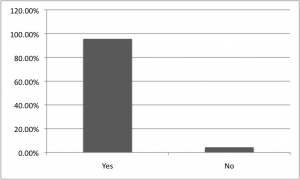
Facebook page - Generation Z
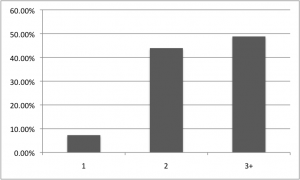
Number of computers owned - Generation Y
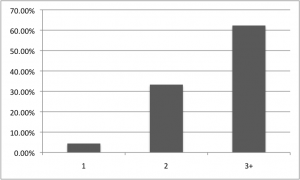
Number of computers owned - Generation Z

Agreement with generational characteristics - Generation Y

Agreement with generational characteristics - Generation Z

Percentage of correct answers to historical quiz - Generation Y

Percentage of correct answers to historical quiz - Generation Z
Students are learning more, but in danger of info overload
January 14, 2010 by Mitch Thompson · Leave a Comment

The overall population breakdown of Kwantlen Polytechnic University, based on age.
Almost half of Kwantlen students are members of Generations Y and Z, according to figures from the Institutional Analysis and Planning department, and were born into a world of personal computers and an explosion of information.
Generation Y includes people born between 1980 and 1989; Generation Z is those born in 1990 and subsequent years. Student records show that 48.8 per cent of Kwantlen students were born between 1988 and 1992.
The Y and Z designations came from a need for a distinction between the Baby Boomers, who were born after World War Two, and their children, who were born between 1965 and 1980. Those children have been called the “after-boomers.â€
Canadian author Douglas Coupland coined the phrase Generation X in his 1991 novel Generation X: Tales for an Accelerated Culture. He believed the title signified the seemingly contradictory ways of post baby-boom society.
The name caught on,and the Y and Z labels followed.
According to an article on About. com, a New York Times-run website, Gen-Yers value family time and teamwork. Generation Z, however, is more individualistic and puts less stock in family values, according to an article in Australia’s Herald Sun.
But there is one overarching value that the generations share.
“The main value, given their age, is probably a thirst for knowledge and looking for means of meaningful self-expression,†said Peter Clayton, a Kwantlen instructor whose courses focus on media and sociology.
This need to know manifests itself in the widespread use of the Internet to discover information and communicate ideas to others.
“The more serious-minded of them spend an enormous amount of time online in the quest for knowledge,†said Clayton.
The older ways of researching, using libraries and books, are slowly being phased out in favour of websites such as Wikipedia or Google.
It’s a change that allows them to learn while delivering the content in a way that is culturally relevant to them, explained Clayton.
However, this cultural inclination towards technology has created never-before-seen consequences for those of Generations Y and Z.
“The downside of all the information technology is that, as far as
leisure time is concerned, people spend more time on their own,†said Clayton.
Generations Y and Z are characterized by physical isolation.
Though they may be talking to friends online, they are still alone at a computer, which can have a negative effect on how they socialize in public.
“On one hand [their culture] encourages them to be more outward-looking,†said Clayton. “But on the other hand, it encourages them to be more isolated and inward-looking.â€
As well, constant access to the Internet has created two generations that suffer from information overload, Clayton said.
“They are probably a lot more stressed out than they realize,†he said. The two generations have become walking dichotomies, Clayton believes, as they want to learn as much as possible, but suffer from extreme information overload.
Increasing number of papa bears stay in the den
January 13, 2010 by Katie Lawrence · 1 Comment
There’s an old stereotype of the family: Mom stays home with the kids while dad goes off to work to support his wife and children.
That stereotype doesn’t necessarily apply anymore. More dads are staying home while moms are the family breadwinners, says Kwantlen sociology instructor Seema Ahluwalia.
Those are fathers like Chad Skelton, reporter for the Vancouver Sun and current stay-at-home father. He’s in the middle of an unpaid leave of absence from his job to stay home with his 18-month-old son.
“I’ve actually enjoyed it a lot more than I thought I would,†said Skelton. “I was worried that as the year got closer, that I might find it boring, and there are moments, but I really enjoy it a lot.â€
Skelton, 33, has been home with his son since March and although he loves it, his role at home still isn’t understood by some older men.
“People my age are completely fine with it, but people, especially older men, from my parents’ generation, assume that it would be boring to stay home for a year,†he said. “They always ask me what I do with my time.â€
His response is that he takes his son out to places in the city such as
the aquarium or the park on nice days. And his son has two naps a day, giving Skelton some time to work on the weekly parenting column that he writes for the Sun or to mark papers from the class he teaches one night a week.
Not all men take to stay-at-home parenting like Skelton does, though.
“I’ve got a friend who works at one of the police departments and under his contract, he can take three months off once he has a kid, but he’s not sure if he’s going to because he might get teased.â€
Ahluwalia, who has been teaching for 10 years, finds the worries of a stay-at-home dad not being a “real man†common.
“We hear a lot from stay-at-home dads about the stereotype of not being treated like a real man because they’re not getting a real job,†she said.
“Men still feel that pressure about not being the breadwinner. It’s one of those stereotypes that chips away at their masculinity.â€
Ahluwalia said that after 40 years of cultural changes, before which a father as the stay-at-home parent was “utterly inconceivable,†roles have changed into more of a whocan-actually-do-it-right-now style of parenting.
“With the economy becoming more and more expensive over the years, that has forced the ways of parenting to change. Sometimes, the woman has a better job and, for that family, it might be a better solution with the dad staying home,†said Ahluawalia.
Ahluwalia is a working mother and her husband stays at home with their child for most of the day. She and her husband are known as “radical unschoolers,†which means they don’t send their child to public school. They let their son “learn about the world around him in ways that engage him.â€
Her husband, a ceremonial leader in his Lakota First Nation, takes their seven-year-old son around to all his lessons, which include piano, horseback riding and art.
“My husband and I see ourselves less as teachers and more like facilitators. Our son wouldn’t be able to have the schooling experience he’s having if my husband didn’t stay at home,†she said.
Statistics show that stay-at-home dads are becoming more common in Canada.
“In 1976, there were 36,000, whereas now, there are 77,000,†said Ahluwalia.
With more women getting into the workforce, she said, it’s not as easy for a man to graduate from school, get the ideal job and live the stereotype.
Emerging from the shadow of divorce: Today’s youth slower to marry than previous generations
January 13, 2010 by Abby Wiseman · Leave a Comment

UBC professor Barbara Mitchell says young people's desire to get married and stay with someone forever hasn't disappeared. (Abby Wiseman photo)
In a 1979 article in the Globe and Mail called “Did the family unit become the casualty of the seventies?†a bleak picture of what divorce had done to society was painted.
“There were runaway wives and mothers; children were kidnapped by divorced parents who didn’t have custody; middle-aged men going through what psychologists termed the male menopause walked out on their wives of 20 or more years and took up with much younger women,†said the Globe and Mail.
The article described children of divorced parents as “latch-key kids†because they lived in high-rise apartment buildings without parents waiting for them after school.
Barbara Mitchell, a sociology professor at UBC said she feels that the image of divorced families in the past wasn’t fair.
“A lot of these children were regarded as different. I think there was this stereotype that divorce would lead to all kinds of problems with children and family dysfunction, and kids would grow up to be delinquent criminals and have a lot of these psychological problems,†said Mitchell, who has studied family relations for 20 years.
Thirty years after the Globe and Mail article was written, being a kid of divorce is, for many, just being a part of the club.
Erica Bauer was 15 years old when her parents split up and she joined most of her friends who had already been through a family break-up.
“When I was in elementary school, most of my friends’ parents were getting divorced then and I was one of the only people who had parents together,†said Bauer, now 23 and living with her boyfriend. “When they ended up getting divorced, I was just like everybody else.â€
According to StatsCan, divorce hit its peak in 1987, around the time many generation Xers were kids and Ys were being born. In that year, according to StatsCan, there were 96,200 divorces. The laws for divorce were softened in 1985, when the Divorce Act was revised and anyone was allowed a divorce as long as they could prove they had lived apart for one year.
Divorce became an everyday occurrence, and with that the opportunity arose for generation X and Y to do what other generations couldn’t: break with tradition.
Instead of going from dating to marriage, many people started taking a middle-step by living together in a common-law relationship before marrying or choosing not to marry at all.
In 1991, according to StatsCan, there were 719,000 common-law couples in Canada, and in 2006 the number nearly doubled to 1,377,000.
“I don’t think that the institution of marriage is going away and the ideal of wanting to marry somebody for a lifetime, you know till death do us part … I think most young people still ideally want that,†said Mitchell, who sees co-habitating before marriage and common-law relationships as the way of the future.
The average age of marriage has gone from 24 for women and 27 for men in 1968, to 32 for women and 34 for men in 2005, reports StatsCan.
Colin Macdougall, 25, can’t envision himself getting married, but doesn’t write it off. Macdougall was 17 years-old when his parents divorced, something he says affects the way he thinks about marriage and relationships.
“I think it is probably right for some people, but I think it’s a little different in this day and age to get married,†said Macdougall. “People have different values and I think people are beginning to understand that they don’t need to be in marriages as much anymore.â€
In 2005 there were were 71,000 divorces according to StatsCan. A 26 percent decrease that Mitchell feels can be attributed to generation
X and Y’s cautious attitude towards marriage, a trait which distinguishes them from their parents.
However, Mitchell said that even with all the precautions, marital instability is a common trait among those from divorced parents.
Despite concerns, children ‘safe as ever’
January 12, 2010 by Kirk Darbyshire · Leave a Comment
The ways we keep children safe have changed from generation to generation, but nothing compares to the way today’s kids are monitored.
Events such as Richmond Centre Mall’s Halloween trick-or-treating for kids, which brought them off the street and into a supervised atmosphere to go store-to-store collecting candy, are becoming commonplace.
“I think events like mall trick-or-treating are crucial these days to making parents feel comfortable,†said Pamela Lau, a teacher at Small Talk Preschool in Vancouver. “It’s not like it used to be. Parents these days pay much closer attention to who’s watching their kids and even who’s watching the people watching their kids.â€
As a result of increased fear of abduction, preschools and daycares have adopted many new security measures. According to Lau, all children at her school must be signed in and out by both their approved parental guardians and one of the teachers.
Even though people’s fears continue to rise, Statistics Canada num-bers show no substantial increase in the number of Canadian children abducted by strangers over a 10-year period from 1997 to 2007.
During those 10 years, the average number of missing children cases filed with the RCMP yearly was 63,896, with an annual average of only 42 of those being kidnappings by strangers. That number makes up less than 0.001 per cent of all missing-children cases filed during that time period.
“I truly believe children are just as safe as they ever have been, maybe safer,†said Susan Jones, an earlychildhood educator at a downtown Vancouver children’s centre. “With the increased attention facilities pay to children’s safety today compared with 20 years ago, it would be much more difficult for a child of this generation to be taken, period.â€
Jones, who has worked in early childhood education for more than a decade, said she believes increased media coverage of every abduction, or even potential abduction, goes a long way to increasing concern.
In June, the RCMP warned Richmond parents that there was a potential kidnapping threat, and that the target was of elementary-school age and Asian descent. This warning was widely distributed through the media, even though the information the RCMP had obtained about the threat was minimal, according to a Vancouver Sun article.
“We completely understand it might instil fear in people but we want to get the message out to parents. I can’t see any other way this can be done,†Cpl. Jennifer Pound told the Sun.
The RCMP’s plan appears to have worked, because parents kept an even closer watch on their kids than usual, and there were not any kidnappings.
Every school in Vancouver has a school-liaison officer whose job it is to educate parents and students on dangers such as Internet luring and “stranger danger.â€
“We are very proactive with the youth in Vancouver, and work very closely with the Vancouver School Board,†said Const. Lindsey Houghton, media relations officer with the VPD.
Twenty years ago, police techniques for finding missing children included putting their pictures on milk cartons. These days, authorities have many new programs in place to help in the search.
One relatively new tool police utilize in the recovery of abducted children is the Amber Alert Program. The program, which was first used in the United States, was introduced in Alberta in 2002 and was Canada-wide by the end of 2005. Since its inception, there have been 29 Canadian Amber Alerts activated, including four in the last year.
In order for an Amber Alert to be issued by the RCMP, the abduction must first meet the program’s four criteria. Law enforcement must confirm that an abduction has taken place, the abducted child must be under 17 years of age and be at risk of death or serious injury, and there must be a sufficient description of the child, the captor and the captor’s vehicle.
Amber is a acronym based on the U.S.-program name: America’s Missing: Broadcast Emergency Response. Amber Alerts in both Canada and the U.S. are distributed via radio stations, cable TV, e-mail and electronic traffic-condition signs.
The flat-screen rock ‘n’ roll revival
January 12, 2010 by Jacob Zinn · Leave a Comment

Alto sax student Laurence Cain, 18, watches guitar student Kyle Poehlke, 21, plays "A Thousand Miles" by Vanessa Carlton on a vintage Fisher Price toy piano. (Jacob Zinn photo)
Parents who remember hearing bands such as the Rolling Stones for the first time when they were kids are now showing their kids these artists for that same experience.
“[My dad] sits in his room, rockin’ out to all that stuff,” said Blake Gervais, 18, a first-year saxophonist in Kwantlen’s music program. “You’re exposed to it ’cause your parents listen to it.”
Gillian White, 18, also a first year saxophonist, added that her parents have control of the radio in the car. “Most of the time, it’s better than the new stuff. They don’t have to fix their voices or anything when they record.”
According to Nielsen SoundScan’s 2008 top-10 list, AC/DC was the second-best selling artist in the United States that year with 3.42 million albums sold. Of those albums, 1.92 million were the band’s 2008 release, Black Ice.
AC/DC, whose members are now aged 54 to 62, released their first album in 1975.
In 2007, the Eagles were the third-best selling artist with 3.6 million albums sold, of which 2.6 million were their 2007 album, Long Road out of Eden, the band’s first album since 1979.
The Eagles, whose members are aged 61 to 62, released their first album in 1972.
In both 2007 and 2008, the rest of the musicians on those top-10 lists were modern artists with high rotation on radio.
Joey Moore, a sociology professor at Vancouver Island University, explained why older music appeals to younger people.
Moore said that some parents force their children to listen to the groups they grew up with, and some teens like the music their parents listened to.
“It’s music their parents pissed off their parents with and they can do the same thing by playing it really loud,” said Moore.
Rebellion through music is associated with youth, and has been for many generations, but Kwantlen guitar teacher Don Hlus said that’s less true today.
“Parents for the most part want to nurture an interest in music, especially in music that the parents understand,” Hlus said. “There’s always these generational gaps and the fact that those are being bridged I think is quite appealing.”
The use of music in video games such as Rock Band and Guitar Hero has also introduced new audiences to older music.
Natascia Dell’erba, 18, a first-year vocalist, said she is surprised to hear her eight-year-old sister singing the Doors and Jimi Hendrix songs featured in these video games.
By releasing games on consoles offered by Microsoft, Sony and Nintendo, game design companies aim to reach a larger market of gamers than if the games were released on one console.
“You have every single side of the video-game world covered,” said Jessica McLaughlin, 18, a first-year saxophonist.
Sales of the 1974 single “Same Old Song and Dance” by Aerosmith increased 400 per cent with the release of Guitar Hero III: Legends of Rock in the 2007 Christmas season, according to an MSNBC article.
“Many artists are very shrewd businessmen,” said Hlus. “They’re going, ‘Hey, this is a generation that doesn’t know our music,’ and they feel there is a universal appeal that’s kind of timeless.’
This music has become a common interest not only between youth and parents, but among youth in different social circles. Moore said that despite differing musical tastes, teens in all cliques tend to enjoy ’60s and ’70s bands.
With the re-emergence of older bands in video games, biographic films and reunion tours, today’s musicians don’t put as much effort into their music.
“[There used to be] more of a focus on the musical ability of the artists rather than how good you look on stage and how much money you can throw at a recording studio,” said Gervais.
Music students interviewed also said that cover versions of old songs can’t match up to the original recordings they were based on.
Depression hits youth hardest, doctors encourage youth to explore alternatives to psychotropic drugs
January 12, 2010 by Kyle Vinoly · Leave a Comment
Canadians under 20 report the higher level of depression, and people between 20 and 29 years of age have the highest levels of anxiety, according to report issued in September by the Canadian Mood Disorders Society.
The most alarming statistics to come out of the report are that 90 per cent of people who commit suicide have a diagnosable mental illness, and that suicide is the cause of death for 24 per cent of Canadians between 15 and 24 years of age, and 16 per cent of those between the ages of 20 and 29.
Women are twice as likely as men to experience depression, and although 80 per cent of people with depression respond well to treatment, 90 per cent of those with depression don’t seek treatment.
“Depression, sometimes it’s a blessing,” said Dr. Hamdy El-Rayes, director of the H.R. Mental Wellness Centre, “because it stops you in your tracks and makes you reflect on the way you’re going and what you need to do.
“Medication does not solve the underlying issues that caused the depression or anxiety.”
El-Rayes said he feels that Canadian youth should explore all options before turning to medication.
He believes that empowering those who have depression or anxiety, and encouraging them to take charge,, is the only successful way to heal someone. El-Rayes said that being younger is an advantage for people, because they have more time to work out issues and aren’t as set in their ways.
Growing up with the Internet and easy access to information has made this generation more open to new ideas, but at the same time has inundated them with too much information.
“Everything is new, and so younger people are willing to accept anything that will help them,” El-Rayes said. From what he sees in his practice, he feels that younger people ask more questions, hesitate to take something just because they’re doctor said to, and are more aware of medication side effects than previous generations were.
Canadians turn to medication more often than not. According to the Mood Disorders Society of Canada, Canadians are the largest users, on aper-capita basis, of psychiatric medications in the world. Canadians are also the secondlargest users of sedatives and the fourth-largest users of prescription narcotics in the world, according to the society. In 2006, there were 51 million prescriptions for psychiatric medications dispensed by Canadian pharmacies, a 32 per cent increase over the previous four years.
“You expect to be able to medicate yourself out of any problem,†said Paul Swingle, a Vancouver psycholo-gist, who argues that simply medicating a problem doesn’t address what caused it in the first place.
“That’s the alcoholic mentality, that you can avoid everything by getting plastered,†he said.
Swingle has seen the consequence of treating depression on the surface rather than at its source.
He has seen many women between the ages of 25 and 40 with a previously undiagnosed form of ADD known as High Frontal Alpha ADD. These women struggled in school, often couldn’t hold a job and, after becoming depressed, were put on a roster of medication to treat their depression. They went undiagnosed because the behaviour associated with the condition are talkativeness and flightiness.
“Since that fit our cultural stereotypes, these unfortunate young girls went undiagnosed,†said Swingle. “So they weren’t treated for the ADD, which created a reactive depression because of failure.â€
The perception of drugs being the answer to emotional problems has been spread effectively by pharmaceutical advertising, which is legal in the U.S and Australia. But because American programing is prevalent on Canadian television, it’s common on our airwaves. A local therapist, Cindy Trevitt, said she feels that this is the greatest threat on the mental landscape for today’s youth.
“The implicit message is don’t feel bad ever, you should feel happy always and not experience life,†said Trevitt, a Vancouver counsellor. “It takes away from our ability to experience life. If I can feel sadness to its great depths I can also feel joy to its great heights.â€
Trevitt argued that although today’s generation may be bombarded by this advertising, it is less influenced by it than previous generations.
Online anonymity results in less privacy
January 12, 2010 by Sarah Jackson · Leave a Comment

Annette Reynolds, sociology instructor at Kwantlen Polytechnic University, refused to allow her face to be published in a statement against the invasion of privacy introduced by internet technologies.
The explosion of personal information on the Internet is leading to “Facebook creeping,†new reasons for being fired, and, according to a Kwantlen sociology instructor, public humiliation.
“[Young people are] more inclined to invade other people’s privacy without feeling invasive about it,†said Annette Reynolds.
“There’s a tendency to feel like you can cross social barriers because there’s an anonymity. That’s a kind of cyber-bullying,†Reynolds said, remembering a time when she read hurtful comments on the teacher-rating web site RateMyProfessors. com.
Cyber-bullying is a rising trend, according to a Microsoft Canada Youthography Internet Safety survey released in February. The survey of people from nine to 17 years old found that 40 per cent of Canadian youth had been bullied online, up from 25 per cent in 2004. It also reported that 60 per cent of youth believe people bully because it is “cool.†More than half of the 16 per cent who said they have cyber-bullied another youth said there were no consequences to their bullying.
“Public humiliation is a form of entertainment,†said Reynolds.
Bullying is one of the side effects of an information free-for-all that includes blogs about people’s personal lives, YouTube videos featuring friends, and Facebook pages full of personal info. Privacy has a different meaning than it used to.
“I don’t think it’s fair to say kids today don’t care about their privacy,†said Micheal Vonn, B.C. Civil Liberties Association policy director. “Previous generations never had to think about this stuff because the system was so different.â€
In the past, privacy was provided by default before technological advances introduced a plethora of information databases. Now that personal information is required in order to access many Internet services, people must choose between those services and privacy. “What we really want is control,†said Vonn.
The government hasn’t hesitated to take advantage of the new opportunities for control, either. Technology-based surveillance, called dataveillance, is increasing as a form of policing and is a worrisome opportunity for state control, she said.
“The new policing philosophy is, ‘Why don’t we just know a whole lot about everybody all the time. Then we’ll be able to do a risk assessment.’â€
Knowing a lot about everybody all the time applies to personal relationships, too. A University of Guelph study released in August indicated that the more time a person spends on Facebook, the more likely they are to become jealous of their significant other because of overexposure to triggers. A person may become alarmed by a comment from someone saying “It was great to see you,†become jealous, and begin “Facebook creeping†that commentator’s profile for more information.
This trend in “Facebook creeping†leads to suspicions, just as government dataveillance does.
“[Data] starts to take on a reality and a life of its own… regardless of if you’ve done anything wrong,†said Vonn.
Employers are pursuing control too, said Michael Cox, who believes he was fired from a probationary bus-driver position with Coast Mountain Bus Company in January because of his blog.
“The company was sensitive to any kind of criticism and certainly sensitive to internal criticism,†Cox said. His blog included information about transit troubles during last winter’s snowstorms. “I think part of it was they wanted to make an example of me.â€
He advised bloggers and social media users to speak their minds but remember that their words could affect them professionally. “There is no such thing as true freedom of the press or true freedom of expression. There’s always going to be a limit.â€
The costs of censoring personal information that is being published online, such as reduced freedom of speech, need to be weighed against the benefits, which include retaining a job. In today’s digital age, the ability to avoid having personal details on the Internet isn’t always there. “The only way to remain a truly private individual would be to only purchase using cash and to be an electronic hermit,†said Cox.
It’s difficult to remain an electronic hermit, and one result is identity theft. Equifax Canada fraud specialist Vanessas Guillani told the Globe and Mail in June that identity theft went up 500 per cent from 1998 to 2003.
Identity theft is a big problem, but personal problems with identity itself are also on the rise. People can take on various identities through social media, which can result in a loss of self, according to Vonn. Internet game Second Life, which mimics real-world activities, including earning income and building relationships, has been featured in the news as a harbinger of real-life problems. A number of game users have adopted their character and attempted to create a perfect life, only to lose their jobs, friends and family. Some have fallen in love with virtual characters only to learn that the real person was not what they expected.
Sidebar: How to protect yourself
• Read privacy contracts, particularly those regarding health, credit-card and banking information.
• Ask questions or refuse to sign things that don’t seem worth it.
• Consider the implications of your pictures, thoughts and videos before you post them.
• Know your employer’s policies concerning social media.
• Remember that once you publish something online, you can never get it back.
Does constant communication help or hinder?
January 11, 2010 by Kristi Jut · Leave a Comment
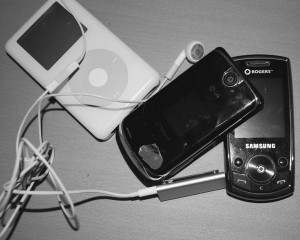 The number of people who have cellphones may have skyrocketed in recent years, but communications instructor Pamela Ip says the basics of communication haven’t really changed.
The number of people who have cellphones may have skyrocketed in recent years, but communications instructor Pamela Ip says the basics of communication haven’t really changed.
Nearly 75 per cent of Canadians owned a cellphone in late 2008, according to Statistics Canada. Just two years earlier, only about 67 per cent of us had one.
In the same report, Stats Can also said households of younger people (18-34) were more likely to own cellphones and, in many cases, to use cellphones only. A slew of cellphone-use statistics put out by a UK online news site, Telegraph, claimed that the average age at which a person begins to use a cellphone is eight-years-old.
Ip said she recognizes the advantages of heightened communication due to the invention of the cellphone, but added that it’s not all positive.
“Technology, with each [new] device, increases communication, but it also creates an unnecessary dependence on it,†Ip said. “We’re so dependent on these things that if people leave their cellphones at home or their e-mail is down for a couple hours, we start to get extremely anxious about that.â€
And anxious we have been conditioned to be, as we now rely on getting our information faster and more efficiently, with the advent of blogging and tweeting. We are being updated on news as it is reported instantaneously, through news sites and blogs, and have learned to communicate in the same way. We send a text-message and expect a response in a minute or less.
But instantaneous communication isn’t necessarily making us more efficient, and, according to Ip, is actually making us more “flaky.â€
“It also makes us think very lastminute; like instead of saying we’ll meet at the restaurant at a certain time, we say ‘I’ll call you when I get to the restaurant,’†said Ip.
Talking on a cellphone while driving has become such a problem that it has been banned in Newfoundland, Ontario, and Quebec, with fines of up to $500.
The B.C. government is also looking to pass a bill to ban cellphone use while driving. B.C. Solicitor General Kash Heed introduced the bill in October. If passed, the new law would take effect Jan.1, although the $167 fine to violaters wouldn’t be implemented until Feb. 1.
The way we communicate and collect information can also leave us with a shorter attention span. A BBC News article titled “Turning into digital goldfish†claimed that “web-browsing can leave you with an attention span of nine seconds— the same as a goldfish.†The article, which relied on the help of Ted Selker from the Massachusetts Institute of Technology, said that our bodies become conditioned to “flitting from one thing to another on the web [so that] we get into the habit of not concentrating.â€
Ip argues that communication itself hasn’t actually changed, but the face of it has.
“Whether you’re talking to a professor or to a peer, you still need to know the fundamentals no matter what the media,†she said.
A changing game: Digital technology has changed our musical lives
January 10, 2010 by Justin Langille · Leave a Comment

Slocan Valley resident Charles Van Toorn picks up world music at Zulu.(Justin Langille/Kwantlen Chronicle)
In his 10-year run as general manager of Zulu Records, Nic Bragg has seen his customers’ connection to music transformed drastically during the revolution brought on by MP3s and the Internet.
“It doesn’t really have a value anymore,†Bragg said. “The relationship has changed. Your music tastes are constantly evolving and you’re constantly consuming, as well as purging music.â€
The devaluation of music has been encouraged by the transition of traditional music journalism into the online forum, Bragg said. He said that taste-making websites like Pitchfork.com have encouraged lifestyle branding of artists.
“I went to Chicago to their [Pitchfork’s] music festival and basically, it’s like a Wal-Mart of independent culture. Shoe companies and other companies are paying to be at the festival to market to the demographic,†he said.
Bragg is skeptical about Pitchfork’s willingness to turn music fans into customers for corporate wares, a common practice in commercial culture, but guarded against in grassroots music circles. Most of them that is.
On the other side of Vancouver, Edo Van Breeman, owner of label Unfamiliar Records, is ecstatic about Pitchfork’s marketing power.
Unfamiliar Records is the Canadian home of Pitchfork favourites Japandroids. Last year, Van Breeman sent Pitchfork a press release for the punk band’s debut album, Post-Nothing. The album was immediately given the prestigious Best New Music title, the site’s gold seal of approval. Overnight success ensued.
“You could attribute, at least preliminarily, 100 per cent of their success to that review,†said Van Breeman. “Pitchfork is a unique case. They’re like the online, modern Rolling Stone.â€
Although Van Breeman believes that Pitchfork’s support was pivotal to Japandroids’ success, he also thinks that if the band hadn’t gone on the road to meet fans and tour as much as it did afterwards, it wouldn’t have done so well.
“You also have a lot of best-new-music designations that don’t do as well as Japandroids. I think that has a lot to do with how the band has toured and how the band is marketed. It’s not like you get the review and bingo, you’re a big band. You have to work for it as well,†Van Breeman said.
Bragg concedes that around 2006, when Zulu Records started to see a decline in sales because of music pirating and online sales, a renaissance in live music began. As musicians could count less and less on traditional income from the sales of LPs and CDs, they hit the road to deliver their art in person and revive the relationship between bands and their fans.
Speaking to BBC News in 2007, Stuart Galbraith, the UK managing director of LiveNation (one of the biggest concert promotion companies in the UK and North America), said that the sales of festival tickets in the UK were surging “beyond belief,†and that the live music scene in the UK was doing better than he could ever remember.
“Live music is the ultimate experience,†Galbraith told the BBC. “It’s not bootleggable, you can’t replicate it, you can’t steal it, and you can’t mimic that experience of actually standing at a gig the roar of the crowd, the smell of the greasepaint.â€
Vancouver blogger Quinn Omori would agree: he would even take it one step further. A UBC IT technician by day, Omori runs From Blown Speakers, a modest blog that presents an exhaustive list of nearly every show going on in Vancouver.
He believes that the amount of music available online hasn’t lessened the value of music for fans, but has allowed people to find music that inspires them to make music themselves, perhaps the most intimate relationship one can have with music.
“Anything you can possibly think of, anything that you might want to hear or want to emulate, you can find,†Omori said. “And you can probably find a bunch of people wanting to do the same thing.â€
Back at Zulu records, Bragg and his coworkers are still managing to get by. Pitchforkapproved artists, Canadian independent music and timeless favorites like Zeppelin and Hendrix still sell, and vinyl is making a moderate comeback among the hipster set.
Bragg said that Zulu could expand into literature and video games, the way HMV has in recent years, but he thinks the chemistry is good enough for now.
“It’s a specialized thing now. The things that you’re looking for here, you can’t find in every corner store. The record store could become pretty much like Urban Outfitters if it really wanted to, but we’re not interested in that.â€


